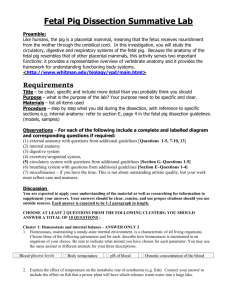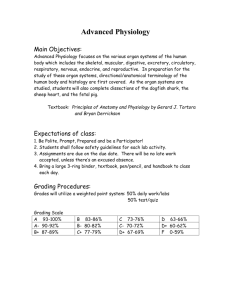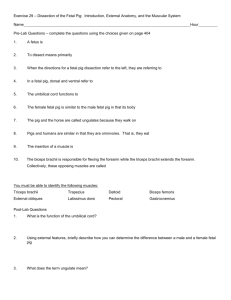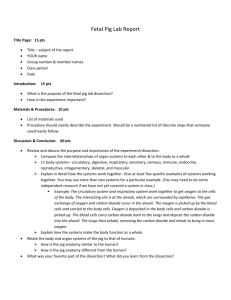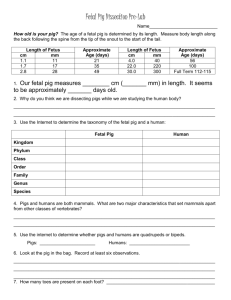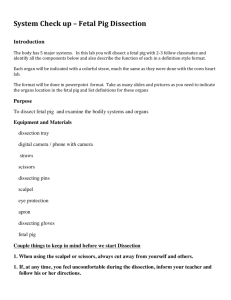Humans vs. Fetal Pigs
advertisement
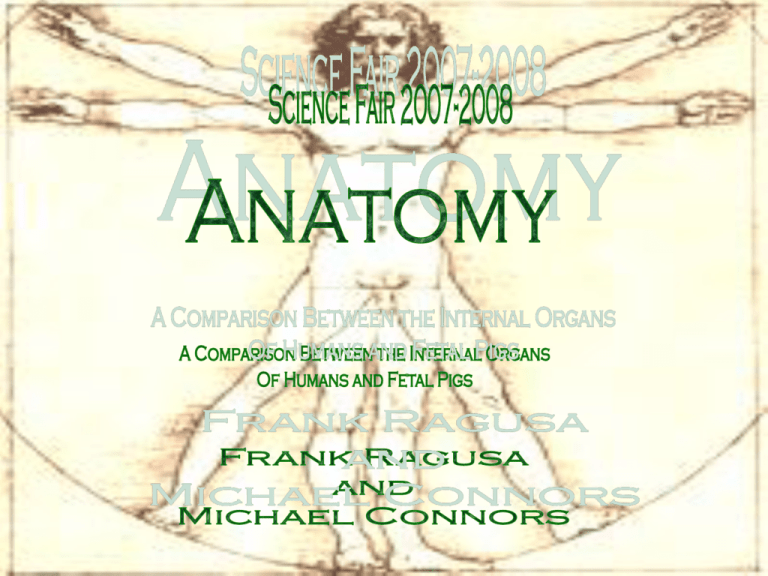
Our Project One of the greatest mysteries of science is the quest to learn about our bodies. The question, “What makes us work the way we do?” has been asked for centuries. Our project is meant to help find a way for a high school student to come one step closer to finding the answer to that mystery. Our project will be focused on the circulatory system, one of the major systems of the human body. The reason? It’s simply one of the most interesting of the systems. Now that we have a general idea of our goal, let’s look at a little background research. The Human Body The human body is driven by a complex relay of organs and tissues working together in order to drive us forward. Those relays make up eleven organ systems. Those systems are: -Skeletal (Provides support/protection for organs) -Muscular (Responsible for locomotion) -Integumentary (Protects from outside environment) -Endocrine (Uses hormones to aid bodily functions) -Nervous (Senses outside factors; controls body) -Lymphatic (Protects body from disease) -Digestive (Processes food into energy) -Excretory (Eliminates harmful waste) -Reproductive (Responsible for creation of new life) -Respiratory (Takes in oxygen from outside) -Circulatory (Brings Oxygen to all parts of body) Routes of Supply: The Circulatory System The circulatory system is a marvel of the natural world. It is made up of a vast, interlocking network of veins, arteries and capillaries. Blood, a mixture of liquid plasma, platelets, and red blood cells, is continuously pumped through these passageways by the heart, a fist-sized muscle divided into four chambers. The path of blood is relatively simple. We’ll start out at the heart, where freshly oxygenated blood is pumped through the arteries to the destination for its payload. Having delivered the much-needed oxygen, the blood transfers to the other main blood vessels, the veins, through the capillaries. It then returns to the heart, and is sent to the lungs to pick up more oxygen. The cycle then begins again. Premise We wanted to study the human body, but it’s very difficult too find a good way of studying our own bodies. One of the best ways to examine the physiology of an organism is dissection. For obvious reasons, that’s not an option for us. However, it did lead us to other possibilities. Was there another organism that could be used in our place? We started by looking at our options. Frogs, rats, and earthworms all appeared on the list. We had to narrow down our choices. And so we decided to close our search to mammals. And then, we hit on something; besides outward physical features and intelligence, one somewhat unusual feature is our diet. We’re omnivores. That breakthrough made one possible specimen stand out from the rest: a fetal pig. Was this the animal we were looking for? Execution Our project will focus on the circulatory system. Now, as there’s no specific procedure for a dissection, we’ll just go over what we did. 1. Make an incision coming down from the neck to the abdomen. 2. Carefully part organs, removing only what is needed. Identify any organs and important items. 3. Record results and take pictures as you see fit. 4. Properly dispose of materials. Internal Organs After First Incision Brain Rib Cage and Spine Heart Organs Observations When we dissected the fetal pig, the similarities between the specimen’s physiology and that of the human body in the diagrams we were using for reference were striking. -General human features located in pig: Lungs, liver, kidneys, stomach, intestines, ribcage, spinal cord, skull, brain, and so on. -Circulatory system: Not only were we able to locate the heart and major passageways (aorta, pulmonary veins, cardiac arteries, vena cava, etc.), but they were in virtually the same place as we saw in the human diagram. It seems that the fetal pig’s internal anatomy is almost identical to ours. Rib Cage And Spinal Cord Pig Heart Organs After First Incision Fetal Pig Anatomy Route of Circulation In Conclusion… The human body is a marvel of nature. The reasons as to why able to walk, talk, breathe, and think creatively will always be beyond our understanding. However, the ability to dissect an animal as close in physical makeup to us as a fetal pig will bring a High School student as near as possible to comprehending the incredible science of human anatomy. And so, our decision is that, due to the similarities both outward and inward, a fetal pig is close enough to a human to be used to study our anatomy. Sources and Acknowledgements “Objective 2: Systems.” Room D113. 2007 http://www.roomd113.com/TAKS%20NOTES/Objective%202%20Systems. pdf. “Fetal Pig Dissection.” The Biology Web. 2007 http://faculty.clintoncc.suny.edu/faculty/Michael.Gregory/files/Bio%2 0102/Bio%20102%20Laboratory/Fetal%20Pig/Fetal%20Pig.htm. “Fetal Pig Anatomy.” The Biology Dept. at Davidson. 1 January 2005 http://www.bio.davidson.edu/courses/bio112/bio112labman/cppig.html. “Bio: Pigs and Sheep.” Onionoz.com. 1 November 2005 http://www.oninoz.com/gallery/bio. All music taken from the, “Gears of War Soundtrack.” Composer – Kevin Reipl (Copyright 2007 Microsoft)

